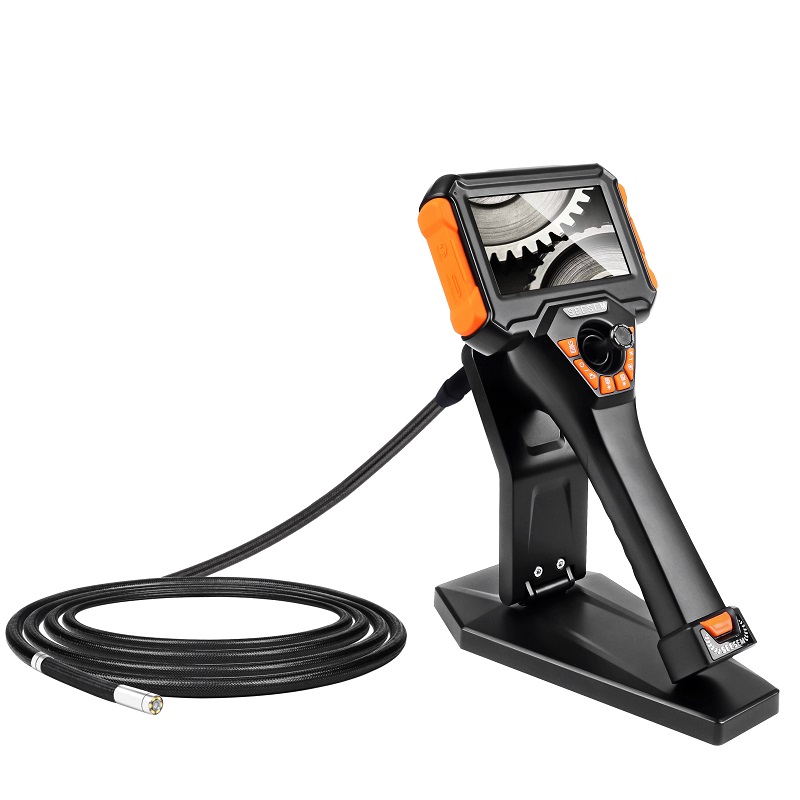Видеобороскопы, также известный как камеры инспекции или эндоскопы, являются важными инструментами для неразрушающего тестирования в различных отраслях, таких как аэрокосмическая промышленность, автомобильный, и производство. Эти устройства произвели революцию в том, как профессионалы осматривают труднодоступные области машин и оборудования. В этой статье, Мы обсудим ключевые функции видеосопопов видео.
- Высококачественная визуализация: Видео-борископы оснащены камерами с высоким разрешением, которые производят ясные, Высококачественные изображения проверенной области. Изображения можно просмотреть в режиме реального времени на встроенном экране устройства или переданы на компьютер или мобильное устройство для дальнейшего анализа.
- Гибкий и долговечный: Вставка трубки видео -борескопа сделана из гибкого материала, который позволяет ему сгибаться и маневрировать вокруг углов и препятствий. Вставная трубка также долговечна и может противостоять суровой среде, Сделать его идеальным для использования в промышленных условиях.
- Портативный и легкий: Видео -борископы предназначены для портативных и легких, Облегчение их транспортировки на разные места работы. Их можно легко перенести в рюкзак или набор инструментов, И некоторые модели даже поставляются с корпусом для переноски для дополнительной защиты.
- Удобный интерфейс: Большинство видео-бороскопов поставляются с удобным для пользователя интерфейс, который позволяет профессионалам легко регулировать настройки камеры, такие как Zoom, фокус, и освещение. Это позволяет легко запечатлеть идеальное изображение для анализа и проверки.
- Универсальный: Видео -борископы могут использоваться в различных отраслях промышленности, От авиации и аэрокосмической промышленности до автомобилей и производства. Они могут быть использованы для осмотра двигателей, трубы, и другие труднодоступные области машин и оборудования.
- Рентабельный: Видео-бороскопы являются экономически эффективной альтернативой традиционным методам проверки, такие как демонтаж оборудования или использование рентгеновских машин. Они позволяют профессионалам проверять оборудование, не нанося ущерба или нарушения, который может сэкономить время и деньги.
В заключение, Видео -бороскопы являются важными инструментами для профессионалов в различных отраслях промышленности. Они предлагают высококачественную визуализацию, гибкость, долговечность, портативность, удобный интерфейс, универсальность, и экономическая эффективность. С их многочисленными чертами, Видео-бороскопы произвели революцию в неразрушающем тестировании, облегчение проверки, безопаснее, и более эффективно.

- Обнаружение дефектов: Видеососы идеально подходят для обнаружения дефектов в машине и оборудовании. Они могут проверять внутренние компоненты без необходимости демонтажа, сокращение времени простоя и стоит. Дефекты, такие как трещины, коррозия, и износ можно легко идентифицировать с использованием видео -боросопов.
- Профилактическое обслуживание: Видео -бороскопы могут быть использованы для профилактического обслуживания, Позволяя профессионалам обнаружить потенциальные проблемы, прежде чем они станут серьезными проблемами. Это помогает сократить время простоя оборудования и увеличивает срок службы машин и оборудования.
- Контроль качества: Видео -борископы используются в процессах контроля качества, чтобы обеспечить соответствие продуктов отраслевые стандарты. Они могут осмотреть внутренние компоненты продуктов и выявлять любые дефекты, которые могут повлиять на их производительность.
- Инспекция безопасности: Видео -борископы используются для инспекций безопасности в различных отраслях промышленности. Они могут осмотреть внутренние компоненты оборудования и выявлять любые потенциальные опасности или проблемы безопасности, такие как утечки или трещины.
- Исследования и разработки: Видеососы используются в исследованиях и разработках для изучения внутренних компонентов машин и оборудования. Это помогает инженерам лучше понять дизайн и функцию оборудования, что может привести к улучшению производительности и эффективности.
- Проверка аэрокосмических компонентов: Видео -боросопы особенно полезны в авиационной промышленности для проверки внутренних компонентов авиационных двигателей и других критических частей. Они могут определить дефекты, которые могут вызвать сбои или неисправности, который может быть катастрофическим.
В заключение, Видео -боросопы - это универсальные инструменты с широким спектром приложений. Они необходимы для обнаружения дефектов, Профилактическое обслуживание, Контроль качества, Инспекция безопасности, исследования и разработки, и проверка аэрокосмических компонентов. С их способностью проверять труднодоступные области без демонтажа, Видео-бороскопы произвели революцию в неразрушающем тестировании и стали важным инструментом для профессионалов в различных отраслях промышленности.
Видео об использовании видеосопопов видео
Q.: Насколько далеко может вставить трубку видео -борископа?
А: Длина вставленной трубки варьируется в зависимости от модели видео -борескопа. В целом, Вставная трубка может достигать нескольких метров, Позволяя профессионалам осматривать глубоко внутри машин и оборудования.
Q.: Можно ли использовать видеосокоры во влажных средах?
А: Да, Видео -боросопы могут использоваться во влажной среде. Однако, Важно выбрать видеосопороп с водонепроницаемой вставленной трубкой и головкой камеры, чтобы убедиться, что устройство может противостоять воздействию воды и других жидкостей.
Q.: Как отрегулировать фокус видеосокорика?
А: Большинство видео -бороскопов поставляются с регулируемой функцией фокуса. Фокус можно настроить с использованием элементов управления устройства, такие как кнопки увеличения и фокусировки. Некоторые видеосокопы также имеют встроенную функцию автофокусировки, которая автоматически регулирует фокус по мере необходимости.
Q.: Можно ли использовать видеосопоры для осмотра живых проводов или электрических систем?
А: Не рекомендуется использовать видеосопоры для осмотра живых проводов или электрических систем, так как это может быть опасно и может вызвать электрическую точку зрения. Важно отключить источники энергии перед проверкой электрических систем или для использования другого типа инструмента проверки, разработанного специально для электрических систем.
Q.: Какова максимальная температура, которую могут противостоять видео -борезопам?
А: Максимальная температура, которую могут выдерживать видео -боросопы, варьируется в зависимости от модели. Важно выбрать видеосопороп, который предназначен для конкретного температурного диапазона проверенной среды.. Некоторые видеороскопы могут выдержать температуру до 2000 Степени Фаренгейт.
Q.: Можно ли использовать видеосокоры для осмотра топливных баков?
А: Да, Видео -боросопы могут использоваться для проверки топливных баков. Однако, Важно использовать видеосопороп, который предназначен для использования в опасных средах и следовать протоколам безопасности при осмотре топливных баков.
Q.: Как почистить видео борескоп?
А: Видео -боросопы должны быть очищены после каждого использования, чтобы убедиться, что они функционируют должным образом и предотвращают повреждение устройства. Вставка трубки и головки камеры могут быть очищены мягкой тканью или кистью и чистящим раствором, специально разработанным для видеосопопов. Важно следовать инструкциям производителя по очистке устройства.





